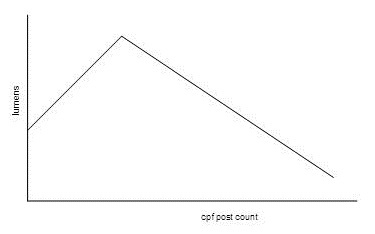wweiss
Enlightened
Of brightness perception and 1 Lumen Dog Walking - Henry Schneiker is right…
I bought a 200 Lumen HICRI HDS Rotary last month and initially wondered what use it would be. It was very well made, but its max output was 200 lumens. I own a DS4 and a TC20, either of which could melt this thing to a puddle of molten aluminum. I own Hound Dogs and Wildcats, M61HOTs and 91Bs. All of them far out-lumen this very expensive, but very well made gadget. I was regretting spending the big money for this light when I happened to read Henry Schneiker's FAQ website page section - How can I see further?…
It was a revelation.
Following Henry's advice, I now use his great light to walk the dark woods, trails and rural roads of southeast CT set to - 1.1 Lumens. Sometimes, if it's dark enough with no moon, I go down to - .15 Lumen. I can see just fine. And the single RCR123A Efest lasts for 22-45 hours or more before a recharge.
From the HDS website:
"We are going to show you a simple method to take advantage of how your eyes work and how your flashlight works to see the furthest possible distance - further than you can see with other flashlights with the same output rating. But first, you need some additional information so you understand how this method works." ---- Henry Schneiker
"…The answer is dark adaptation. With the bright light, it is difficult to avoid over illuminating the scene and ruining your dark adaptation. With dim light, it is easy to build your dark adaptation, which counts as several additional brightness levels when you turn on the maximum output. Two additional brightness settings allow you to see 50% further. Three brightness settings allow you to see 84% further. Four brightness settings allow you to see 125% further - that's over twice as far." ---- Henry Schneiker
Try this at home. Go out into the dark (woods road, warehouse, country lane, trail) at the lowest level your light has and let your eyes dark-adapt (about 7-10min). You should find that even the 'moonlight' settings on most lights are too bright. If something does bump in the night just outside your low level glow, do a tactical high blast to see it and you will be amazed at how you will think you've got 20,000 Lumens in your hand, not 200.
Since it's wise to carry at least two lights, I have the HDS Rotary for low-lumen guidance and the latest version of the Armytech Predator Pro (warm) - probably the best pocket thrower available - for a very high, long throw-blast. With this method, batteries last for many hours and run-time worries a thing of the past.
I bought a 200 Lumen HICRI HDS Rotary last month and initially wondered what use it would be. It was very well made, but its max output was 200 lumens. I own a DS4 and a TC20, either of which could melt this thing to a puddle of molten aluminum. I own Hound Dogs and Wildcats, M61HOTs and 91Bs. All of them far out-lumen this very expensive, but very well made gadget. I was regretting spending the big money for this light when I happened to read Henry Schneiker's FAQ website page section - How can I see further?…
It was a revelation.
Following Henry's advice, I now use his great light to walk the dark woods, trails and rural roads of southeast CT set to - 1.1 Lumens. Sometimes, if it's dark enough with no moon, I go down to - .15 Lumen. I can see just fine. And the single RCR123A Efest lasts for 22-45 hours or more before a recharge.
From the HDS website:
"We are going to show you a simple method to take advantage of how your eyes work and how your flashlight works to see the furthest possible distance - further than you can see with other flashlights with the same output rating. But first, you need some additional information so you understand how this method works." ---- Henry Schneiker
"…The answer is dark adaptation. With the bright light, it is difficult to avoid over illuminating the scene and ruining your dark adaptation. With dim light, it is easy to build your dark adaptation, which counts as several additional brightness levels when you turn on the maximum output. Two additional brightness settings allow you to see 50% further. Three brightness settings allow you to see 84% further. Four brightness settings allow you to see 125% further - that's over twice as far." ---- Henry Schneiker
Try this at home. Go out into the dark (woods road, warehouse, country lane, trail) at the lowest level your light has and let your eyes dark-adapt (about 7-10min). You should find that even the 'moonlight' settings on most lights are too bright. If something does bump in the night just outside your low level glow, do a tactical high blast to see it and you will be amazed at how you will think you've got 20,000 Lumens in your hand, not 200.
Since it's wise to carry at least two lights, I have the HDS Rotary for low-lumen guidance and the latest version of the Armytech Predator Pro (warm) - probably the best pocket thrower available - for a very high, long throw-blast. With this method, batteries last for many hours and run-time worries a thing of the past.


